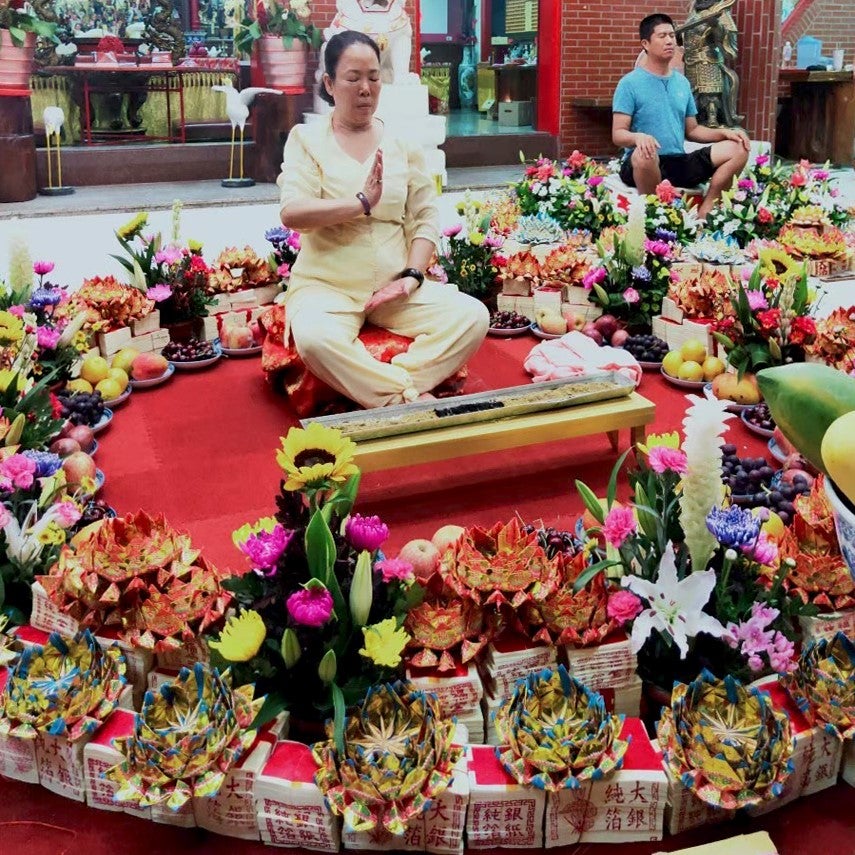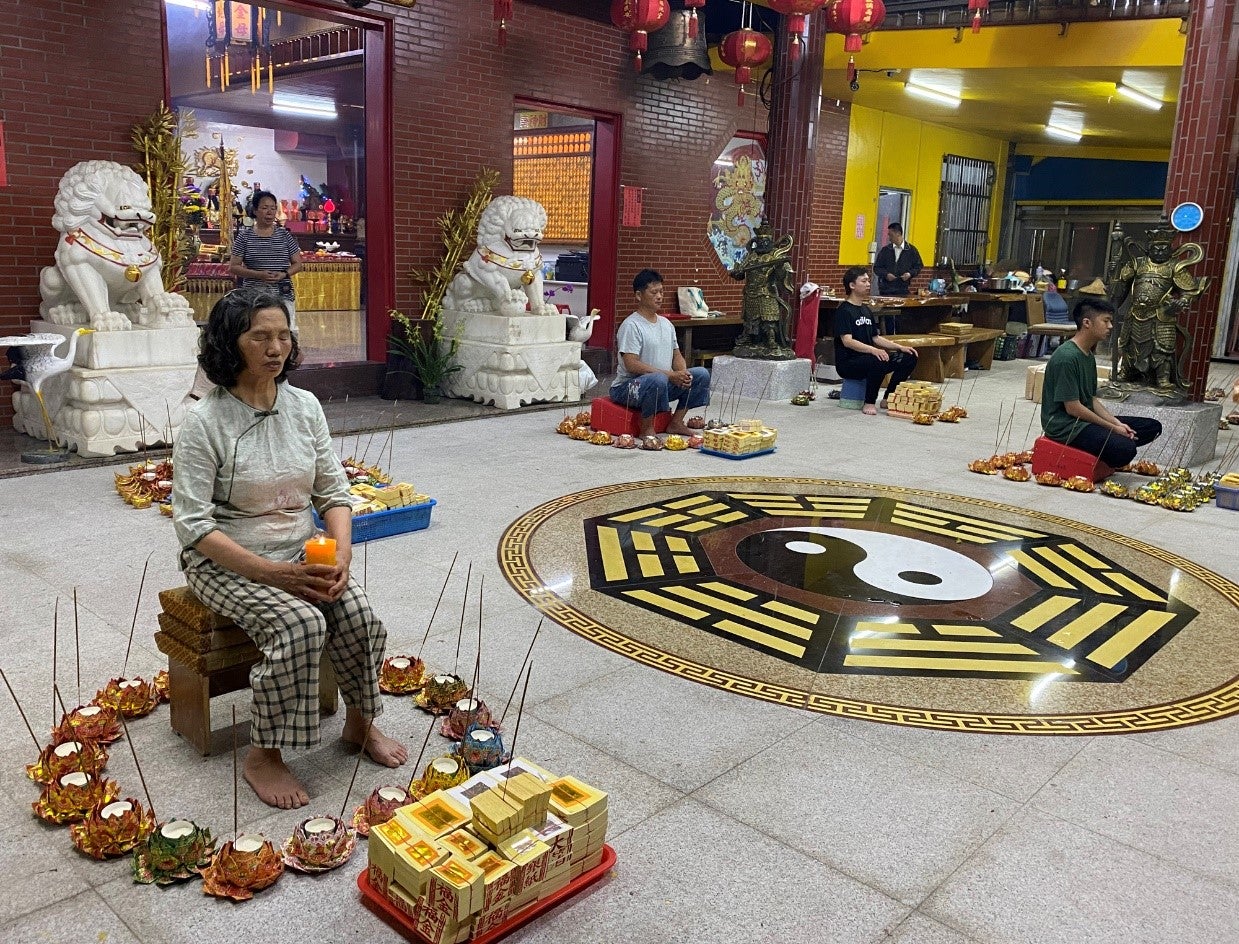Lingji: A religious response to COVID-19 from Taiwan
contributed by Fabian Graham, Photos 3-5 by Wang Chien-chuan, Taiwan, 04 June 2020
The lingji tradition first appeared in Taiwan in the mid-1960s in Hualien City, and found mass popularity across Taiwan by the early 2000s. I will first describe the tradition, its cosmology, ritual practices, material culture and identification with a Taiwanese identity to provide a background in which to frame the tradition’s ritual responses to COVID-19.
Popularised soon after Taiwan’s stock market crash, and further promoted by increasingly tense cross-Strait relations since the advent of democracy, lingji is an indigenous form religious expression in Taiwan, ling corresponding to Western notions of the spirit or soul. The word ji means ‘to divine’ and connects the lingji movement to an earlier tradition of spirit mediumship, a tradition in which deities possess their spirit mediums, ji tong, a term literally meaning ‘divining youths’.
Both traditions are commonly practiced in Taiwan’s contemporary religious landscape. In the lingji tradition, employing elaborate and often spontaneous ritual practices and an inventive material culture, practitioners alleviate their fears of a deteriorating economy, natural disasters, and of the perceived threat of cross-Strait violence at large-scale lingji festivals.
At the temple level where individual practitioners gather, lingji teachers present the tradition as a means of spiritual self-cultivation with a strong pre-occupation on practitioners’ own past-life incarnations (Graham 2018 chapter 7). Lingji ontology dictates that if a ‘being’ dies with negative emotions including jealousy, hatred, or fear, its soul or spirit (ling) remains damaged until either post-mortally gratified or avenged, or, is healed and promoted through lingji rituals to higher spiritual levels.
Therefore, underlying lingji cosmology is the worry of having damaged another’s ling through one’s past-lives misdeeds which, without intervention, may result in this-life misfortunes. Both natural disasters and personal misfortunes may now be interpreted to include the possibility of having one’s life adversely affected by COVID-19.
Over the past decade or so, lingji practitioners have been increasingly aligning their ritual culture with their sense of a distinctly Taiwanese identity. First expressed through using Republic of China (ROC or Taiwan) flags in public rituals, the material and ritual culture has expanded to include maps of Taiwan around which rituals are performed with the intention to protect the island. While to my knowledge there have been no large scale lingji festivals since the advent of COVID-19, at the individual temple level, rituals performed around these maps to keep Taiwan safe have been increasing, as have meditation sessions intended to protect individual practitioners from disease.
The following photos of maps used in rituals are from past events pre-COVID-19, and these will be followed by photos and descriptions of lingji meditation practices which have increased in popularity since the advent of the COVID-19 pandemic.

Photo 1: Lingji festival, Central Taiwan, 2019

Photo 2: Lingji festival, Taipei City 2016
To date, there has been no COVID-19 lockdown in Taiwan, and while religionists may argue that previous lingji rituals performed to keep Taiwan safe have proven successful, the mainstream would attribute this success to a quick response by the government who effectively closed the door to travellers wishing to enter Taiwan in the earlier stages of the pandemic. Nonetheless, as no practitioners would claim that all souls (ling) had been cured and promoted to higher spiritual levels, rituals to prevent COVID-19 effecting individuals, and by extension, communities, continue.
These new rituals have involved both ritual invention and the reinvention of symbols, cosmology, and the use of sacred space to achieve this new purpose. The primary response has been at a temple level rather than through large lingji festivals, as public gatherings would disregard the need for social distancing. While the rituals still focus on healing ling, this is now approached by individuals at their temples rather than at large gatherings in shared public space.
The purpose of the new rituals are pragmatic: to ‘pay off’ the ling of those one has offended or harmed in one’s previous incarnations, and, in the process, negating one’s own past lives negative karma with the goal of increasing one’s good fortune and decreasing one’s misfortune in the present. To achieve this, practitioners meditate within a circle of offerings, offerings which will later be burned, thus transmuting them through fire for use in the spiritual world, while focussing on asking forgiveness from the souls of those one has previously offended or harmed in a past life.

Photo 3: Meditating within a circle of offerings
Looking more closely at the offerings, they inevitably include incense which is both a sign of respect and means of communicating with the spirit world, i.e., ancestral spirits, wandering spirits (ghosts), spirits of those encountered in past incarnations, nature spirits, deity spirits and so forth. From Taoism there are fruit and flowers, two more of the five Taoist offerings which include incense, fruit, flowers, water and light. From Buddhism there are lotus flowers, which have been hand-crafted from joss money decorated in Buddhist symbolism and words from various sutras. In lingji cosmology these spin in the spirit world, and thereby generate spiritual energy which can be used by various ling for self-healing and religious instruction.
Finally there is joss money, which will be incinerated and thereby transferred to the ling addressed during meditation who reside in the spirit world, essentially a bribe accompanied by good intent encouraging any ling with a personal grudge to let go of their anger and move on, and in so doing, to progress to higher spiritual levels or new reincarnations.
The preceding photograph was taken in the early days of the pandemic, and since then, the layout and extravagance of meditation space has been simplified and reduced.

Photo 4: A meditation space in its most basic form
While the number of offerings has been reduced, the essential elements remain. These are incense, light, paper lotuses and joss money, and, in the photo above, rice for the sustenance of the souls in the spirit world. However, of key importance is the way in which the incense sticks point away from the practitioner’s chair, symbolic of both past lives’ negative karma and spirits emotionally attached to the practitioner moving away from their body, and towards the incinerator where the offerings will later be burned.

Photo 5: Practicing social distancing, May 16th, 2020
Even though at the time of writing there have been no new cases of COVID-19 in Taiwan for a week, social distancing is still respected, and following meditation, practitioners are encouraged to wear masks when in public space.
Online resources to explore Buddhist responses to COVID-19 in Taiwan
There have also been non-lingji responses to COVID-19 by Taiwan’s most affluent Buddhist monasteries. Please refer to their individual websites below.
Dharma Drum Mountain Buddhist Monastery, New Taipei City, Taiwan
https://www.dharmadrum.org/content/news/view.aspx?sn=1973
Ling Jiou Mountain Buddhist Monastary, New Taipei City, Taiwan
Buddhist Compassion Relief ‘Tzu Chi’ Foundation, Hualien, Taiwan
Fo Guan Shan Monaterty, Kaohsiung, Taiwan

Fabian Graham is working closely with lingji masters and tang-ki spirit mediums, and adopting a participatory approach to fieldwork where possible, his research interests include the anthropology of Chinese religion; spirit possession; temple ritual and material culture; the invention, inversion and reinterpretation of tradition; visual anthropology; and new ethnographic, narrational and analytical approaches to the study of religious phenomena. While at the ARI Dr Graham will be continuing two projects both of which began in 2010. The first is a comparative study of the Nine Emperor God festivals in Singapore, Malaysia and Thailand, and the second is a long-term study of lingji mediums and new deity cults in Taiwan.
Disclaimer: The views and opinions expressed in this article are those of the authors and do not necessarily reflect the position of the blog editorial team or the Asia Research Institute.
South Asia | Southeast Asia | East Asia | Other Places | Hinduism | Buddhism | Islam | Christianity | Other Religions

